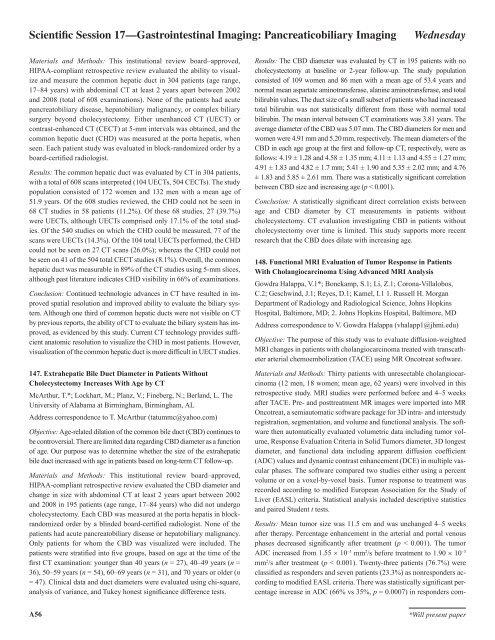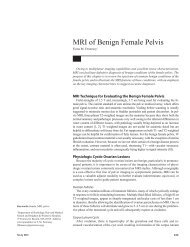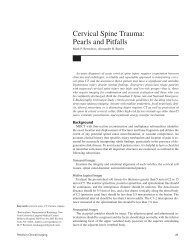Scientific Session 1 â Breast Imaging: Mammography
Scientific Session 1 â Breast Imaging: Mammography
Scientific Session 1 â Breast Imaging: Mammography
You also want an ePaper? Increase the reach of your titles
YUMPU automatically turns print PDFs into web optimized ePapers that Google loves.
<strong>Scientific</strong> <strong>Session</strong> 17—Gastrointestinal <strong>Imaging</strong>: Pancreaticobiliary <strong>Imaging</strong>WednesdayMaterials and Methods: This institutional review board–approved,HIPAA-compliant retrospective review evaluated the ability to visualizeand measure the common hepatic duct in 304 patients (age range,17–84 years) with abdominal CT at least 2 years apart between 2002and 2008 (total of 608 examinations). None of the patients had acutepancreatobiliary disease, hepatobiliary malignancy, or complex biliarysurgery beyond cholecystectomy. Either unenhanced CT (UECT) orcontrast-enhanced CT (CECT) at 5-mm intervals was obtained, and thecommon hepatic duct (CHD) was measured at the porta hepatis, whenseen. Each patient study was evaluated in block-randomized order by aboard-certified radiologist.Results: The common hepatic duct was evaluated by CT in 304 patients,with a total of 608 scans interpreted (104 UECTs, 504 CECTs). The studypopulation consisted of 172 women and 132 men with a mean age of51.9 years. Of the 608 studies reviewed, the CHD could not be seen in68 CT studies in 58 patients (11.2%). Of these 68 studies, 27 (39.7%)were UECTs, although UECTs comprised only 17.1% of the total studies.Of the 540 studies on which the CHD could be measured, 77 of thescans were UECTs (14.3%). Of the 104 total UECTs performed, the CHDcould not be seen on 27 CT scans (26.0%); whereas the CHD could notbe seen on 41 of the 504 total CECT studies (8.1%). Overall, the commonhepatic duct was measurable in 89% of the CT studies using 5-mm slices,although past literature indicates CHD visibility in 66% of examinations.Conclusion: Continued technologic advances in CT have resulted in improvedspatial resolution and improved ability to evaluate the biliary system.Although one third of common hepatic ducts were not visible on CTby previous reports, the ability of CT to evaluate the biliary system has improved,as evidenced by this study. Current CT technology provides sufficientanatomic resolution to visualize the CHD in most patients. However,visualization of the common hepatic duct is more difficult in UECT studies.147. Extrahepatic Bile Duct Diameter in Patients WithoutCholecystectomy Increases With Age by CTMcArthur, T.*; Lockhart, M.; Planz, V.; Fineberg, N.; Berland, L. TheUniversity of Alabama at Birmingham, Birmingham, ALAddress correspondence to T. McArthur (tatummc@yahoo.com)Objective: Age-related dilation of the common bile duct (CBD) continues tobe controversial. There are limited data regarding CBD diameter as a functionof age. Our purpose was to determine whether the size of the extrahepaticbile duct increased with age in patients based on long-term CT follow-up.Materials and Methods: This institutional review board–approved,HIPAA-compliant retrospective review evaluated the CBD diameter andchange in size with abdominal CT at least 2 years apart between 2002and 2008 in 195 patients (age range, 17–84 years) who did not undergocholecystectomy. Each CBD was measured at the porta hepatis in blockrandomizedorder by a blinded board-certified radiologist. None of thepatients had acute pancreatobiliary disease or hepatobiliary malignancy.Only patients for whom the CBD was visualized were included. Thepatients were stratified into five groups, based on age at the time of thefirst CT examination: younger than 40 years (n = 27), 40–49 years (n =36), 50–59 years (n = 54), 60–69 years (n = 31), and 70 years or older (n= 47). Clinical data and duct diameters were evaluated using chi-square,analysis of variance, and Tukey honest significance difference tests.Results: The CBD diameter was evaluated by CT in 195 patients with nocholecystectomy at baseline or 2-year follow-up. The study populationconsisted of 109 women and 86 men with a mean age of 53.4 years andnormal mean aspartate aminotransferase, alanine aminotransferase, and totalbilirubin values. The duct size of a small subset of patients who had increasedtotal bilirubin was not statistically different from those with normal totalbilirubin. The mean interval between CT examinations was 3.81 years. Theaverage diameter of the CBD was 5.07 mm. The CBD diameters for men andwomen were 4.91 mm and 5.20 mm, respectively. The mean diameters of theCBD in each age group at the first and follow-up CT, respectively, were asfollows: 4.19 ± 1.28 and 4.58 ± 1.35 mm; 4.11 ± 1.13 and 4.55 ± 1.27 mm;4.91 ± 1.83 and 4.82 ± 1.7 mm; 5.41 ± 1.90 and 5.35 ± 2.02 mm; and 4.76± 1.83 and 5.85 ± 2.61 mm. There was a statistically significant correlationbetween CBD size and increasing age (p < 0.001).Conclusion: A statistically significant direct correlation exists betweenage and CBD diameter by CT measurements in patients withoutcholecystectomy. CT evaluation investigating CBD in patients withoutcholecystectomy over time is limited. This study supports more recentresearch that the CBD does dilate with increasing age.148. Functional MRI Evaluation of Tumor Response in PatientsWith Cholangiocarcinoma Using Advanced MRI AnalysisGowdra Halappa, V.1*; Bonekamp, S.1; Li, Z.1; Corona-Villalobos,C.2; Geschwind, J.1; Reyes, D.1; Kamel, I.1 1. Russell H. MorganDepartment of Radiology and Radiological Science, Johns HopkinsHospital, Baltimore, MD; 2. Johns Hopkins Hospital, Baltimore, MDAddress correspondence to V. Gowdra Halappa (vhalapp1@jhmi.edu)Objective: The purpose of this study was to evaluate diffusion-weightedMRI changes in patients with cholangiocarcinoma treated with transcatheterarterial chemoembolization (TACE) using MR Oncotreat software.Materials and Methods: Thirty patients with unresectable cholangiocarcinoma(12 men, 18 women; mean age, 62 years) were involved in thisretrospective study. MRI studies were performed before and 4–5 weeksafter TACE. Pre- and posttreatment MR images were imported into MROncotreat, a semiautomatic software package for 3D intra- and interstudyregistration, segmentation, and volume and functional analysis. The softwarethen automatically evaluated volumetric data including tumor volume,Response Evaluation Criteria in Solid Tumors diameter, 3D longestdiameter, and functional data including apparent diffusion coefficient(ADC) values and dynamic contrast enhancement (DCE) in multiple vascularphases. The software compared two studies either using a percentvolume or on a voxel-by-voxel basis. Tumor response to treatment wasrecorded according to modified European Association for the Study ofLiver (EASL) criteria. Statistical analysis included descriptive statisticsand paired Student t tests.Results: Mean tumor size was 11.5 cm and was unchanged 4–5 weeksafter therapy. Percentage enhancement in the arterial and portal venousphases decreased significantly after treatment (p < 0.001). The tumorADC increased from 1.55 × 10 –3 mm 2 /s before treatment to 1.90 × 10 –3mm 2 /s after treatment (p < 0.001). Twenty-three patients (76.7%) wereclassified as responders and seven patients (23.3%) as nonresponders accordingto modified EASL criteria. There was statistically significant percentageincrease in ADC (66% vs 35%, p = 0.0007) in responders com-A56*Will present paper
















